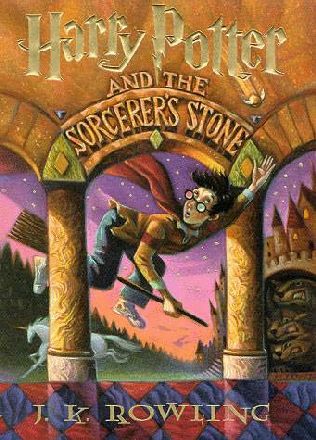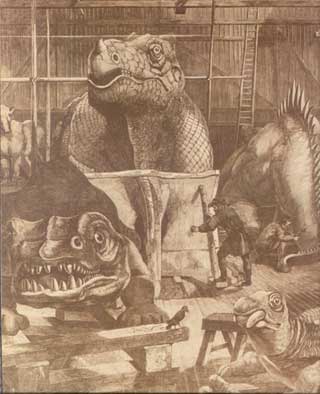Title:Harry Potter and the Sorcerer's StoneAuthor: J.K. Rowling
Illustrator: Mary Grandpr'e
Publisher and Date: Aurthur A. Levine Books, 1997
Genre: Fantasy
Age Range: 4th-6th grade
Summary:Harry Potter is the loneliest, most miserable boy in the muggle (human) world. He’s shunned by his relatives, the Dursley’s, that have raised him since infancy. He’s forced to live in the cupboard under the stairs, to wear his Cousin Dudley’s hand-me-down clothes, and to go to his elderly neighbor’s house when the rest of the family is doing something fun.
On his eleventh birthday, however, Harry’s life changes forever. After much trouble and many letters, a giant named Hagrid informs Harry that he’s really a wizard and will soon be attending Hogwarts School of Witchcraft and Wizardry. Harry also learns of his fame and hero status in the wizarding world; when he was an infant, the evil Lord Voldemort killed his parents and then tried to kill Harry as well, but Harry survived and allegedly destroyed Lord Voldemort in the process!
When Harry hears the news, he is shocked and confused. Can it all be true? Everything Hagrid told him turns out to be true, and with a joyful heart Harry starts wizarding school in September. He quickly becomes best friends with a boy named Ron Weasley, and before they even make it to Christmas, they break a lot of school rules. For example, they attack a troll and prevent it from killing fellow student, Hermione Granger, while they are supposed to be fleeing to their common rooms with their fellow students. After the troll incident, the three become inseparable, and Harry is amazed to have found such great friends. He is constantly busy trying to stay on top of the mounds of homework, as well as participating in weekly Quidditch practices. Quidditch is the most popular sport among wizards and Harry is the youngest Quidditch player at Hogwarts in over a century.
As the year progresses, the three friends set out to solve the mystery of the gigantic three-headed dog that is guarding a secret in the school. They deduce that a very valuable object, the Sorcerer’s Stone, is being hidden in the school (it can lead to eternal life and abundant wealth). They began to suspect Professor Snape (one of the meanest Professors at Hogwarts) of trying to steal the stone, and they quickly take action to circumvent the theft.
Things come to a head when they sneak past the vicious, three-headed dog and go down into the bowels of the school, determined to save the stone. Ron and Hermione help Harry get through the challenges set forth to stop the thief(playing music for the three headed dog, finding the “right” flying key, winning a life size game of chess, solving a potions riddle), but Harry ends up alone to face his final challenge. He is surprised to find Professor Quirrel in the final room also searching for the Sorcerer’s Stone. Professor Quirrel is a follower of Lord Voldemort and they now share one body. Harry is forced to do battle with the Lord Voldemort, and he’s able to save the Sorcerer’s Stone, although he’s almost killed in process. The school headmaster, Dumbledore, arrives just in time to save Harry.
The school year ends spectacularly. Harry, Ron, and Hermione are honored for their bravery and service to the school, Gryffindor wins the House Cup for the first time in seven years, and Harry leaves to go back to the Dursley’s for the summer feeling as if he’s finally found a place where he truly belongs.
Response to Themes:Harry Potter is a fantastical novel full of mystical creatures and magical people, yet it is also a very didactic book. It touches on so many important themes and life lessons that are very applicable to student’s lives today. A theme that runs throughout the story is the importance of one’s name and identity. In the beginning of the book, Harry Potter was the least important resident on Privet Drive or anywhere else for that matter. He was despised by his aunt and uncle, picked on by his cousin Dudley, and treated as an outsider at school. In the muggle world, the name Harry Potter evoked pity and sympathy if anything at all. This all changes however a few chapters into the book. Harry discovers that his name evokes fame, heroism, bravery, and respect in the wizarding world, all because of his actions as a baby. Another character whose name is especially important in the book is Lord Voldemort. His name is so feared that most wizards and witches refer to him as “you know who”. I think that this theme can have two implications for students. The first is that our names are attached to our reputations. We have to make sure that our actions reflect the kind of reputation we would like to have; Voldemort’s actions were evil and wrong, therefore he got the reputation of being evil and his name from then on evoked fear and hate. The second way to view this theme is that we should not judge people by their previous identity or by their name. Harry Potter was the same boy in both the muggle and the wizarding world, yet he achieved so much more in the wizarding world because he had people who believed in him and supported him.
Another important theme from the book is the power of love. One of my favorite parts of the book is when Dumbledore explains to Harry about his mothers love for him. He says, “Your mother died to save you. If there is one thing Voldemort cannot understand, it is love. He didn’t realize that love as powerful as your mother’s for you leaves its own mark. Not a scar, no visible sign….to have been loved so deeply, even though the person who loved us is gone, will give us some protection forever. Quirrell….could not touch you for this reason. It was agony to touch a person marked by something so good.” Love is a powerful emotion and a gift that we can bestow on anyone. To be loved and cared for is probably one of the most important things in life. Love gives us the strength and confidence to face our daily lives.
Prejudice is another important theme throughout the book. Harry’s Aunt and Uncle had prejudice against him and his “kind” throughout the book. Their attitude about him put a wall up between them and kept them from becoming a close family. Prejudices can ruin relationships and reputations. Is it not better to actually get to know someone than to simply think you do? People can surprise you if you take the time to get past what you think you know and actually get to know them. I think this is an especially important lesson for students today. In school there are always kids who are bullied, picked on, and made fun of just because they are different or we have a prejudice against them. In my classroom I want my students to form their own opinions about others (and not just to rely on what they have been taught in the past), and treat everyone with respect.
Another central theme in the book deals with making choices and decisions. Every day of our lives we have to make choices. We decide what to eat and to wear, whether or not to come to school or to try in school, how we treat others, who are friends are, ect. We are literally bombarded with choices everywhere we turn. Some are big choices while others are small choices. Harry was faced with several of each kind throughout the book. He had to decide to trust what Hagrid told him was true about his past, he had to choose what kind of friends he would make at school, and he had to choose to follow his heart to do what he thought was right. Harry’s choices ultimately led him into danger and breaking rules, but also to saving the school and protecting himself and others. Our choices might not always be as big as Harry’s, but we need to always remember that each choice we make is important. Everything we do in life has an impact on us and others.
The final theme that I want to point out is the importance of our dreams. Our dreams are what push through life; they’re what we strive for and work towards. In Harry Potter, dreams are specially represented by a magical mirror, the Mirror of Erised. The inscription of the mirror reads, “erised stra ehru oyt ube cafru oyt on wohsi,” which when reversed reads I show not your face but your heart's desire. According to headmaster Dumbledore, the mirror "shows us nothing more or less than the deepest, most desperate desire of our hearts" When you look into this mirror, it will show you exactly what your hearts desire is. When Harry looks in the mirror he sees his parents and other relatives. He gets to meet them and spend time with them; something he was never able to do in reality. In the book Dumbledore takes the mirror to a new hiding place so that Harry can no longer spend his time looking into it. Dumbledore is teaching Harry a very hard lesson; he is showing him that we cannot just live in our dreams, we have to face reality. Dreams are wonderful and necessary, but if we spend all of our times caught up in fanaticizing about our dreams rather then taking the steps or actions necessary to make our dreams real, then really what good are our dreams? If Harry would have spent his life in front of the mirror it would have been wasted! We can’t just have dreams and desires (to have them is not enough), we have to live our lives in such a way that we actively pursuing them.
The following is my representation of the Mirror of Erised. If I were to look into the mirror at this point in my life, I would see my future classroom filled with students ready to learn and make their mark on the world. My ambition and my dream is to be the best teacher I can be.
When I created this mirror I attached my dream to the mirror with Velcro, that way my students can create their own dreams and place them on the mirror as well.


Finally, these are few of my favorite Dumbledore quotes from the book…….
“The truth….is a beautiful and terrible thing, and should therefore be treated with great caution.”
“Fear of a name increases fear of the thing itself.”














